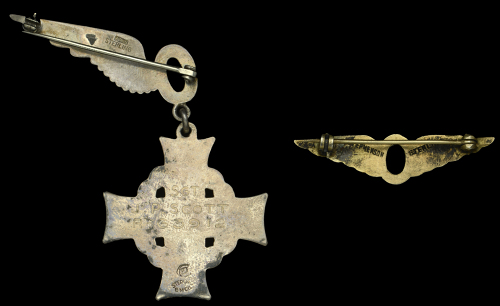Auction Catalogue


Canadian Memorial Cross, G.V.R. (Sgt. J. P. Scott R-63912) suspended from WW2 R.C.A.F. sterling silver and enamel Observer’s brevet wing badge, stamped Birks Sterling, with pin fitting, together with silver-gilt R.C.A.F. Operational wings, stamped Stephenson Sterling, with pin fitting, very fine (2) £200-£300
James Philip Scott, Sergeant (Air Observer) R.C.A.F., attached 22 Squadron R.A.F., was killed in action on 6 April 1942. He is buried in Brest (Kerfautras) Cemetery.
Sergeant Scott was navigator of Beaufort 1, N1016, OA-X, of 22 Squadron flown by Flying Officer Kenneth Campbell, R.A.F.V.R., in a suicidal but successful low-level torpedo attack on the German battle-cruiser Gneisenau in Brest harbour on 6 April 1941. Having released his ‘fish’, crippling the Gneisenau, Campbell’s Beaufort came under heavy flak and was quickly shot down killing all four airmen. Campbell was subsequently awarded a posthumous Victoria Cross, the citation stating:
‘In recognition of most conspicuous bravery. This officer was the pilot of a Beaufort aircraft of Coastal Command which was detailed to attack an enemy battle cruiser in Brest Harbour at first light on the morning of 6th April 1941. The aircraft did not return but it is known that a torpedo attack was carried out with the utmost daring.
The battle cruiser was secured alongside the wall on the north shore of the harbour, protected by a stone mole bending around it from the west. On rising ground behind the ship stood protective batteries of guns. Other batteries were clustered thickly round the two arms of land which encircle the outer harbour. In this outer harbour near the mole were moored three heavily-armed anti-aircraft ships, guarding the battle cruiser. Even if an aircraft succeeded in penetrating these formidable defences, it would be almost impossible, after delivering a low-level attack, to avoid crashing into the rising ground beyond.
This was well known to Flying Officer Campbell who, despising the heavy odds, went cheerfully and resolutely to the task. He ran the gauntlet of the defences. Coming in at almost sea level, he passed the anti-aircraft ships at less than mast-height in the very mouths of their guns and skimming over the mole launched a torpedo at point-blank range.
The battle cruiser was severely damaged below the water-line and was obliged to return to the dock whence she had come only the day before. By pressing home his attack at close quarters in the face of withering fire on a course fraught with extreme peril, Flying Officer Campbell displayed valour of the highest order.’
It is virtually certain that Campbell, having released his torpedo, was almost immediately killed or wounded by the first predicted flak. When the aircraft was later salvaged the Germans found the body of ‘Jimmy’ Scott, the fair-haired Canadian, in the pilot’s seat usually occupied by Campbell. All four crew members were buried by the Germans in the grave of honour in Brest cemetery. Sold with copied record of service and other research including several copied news cuttings, one of which erroneously states that Scott was awarded a posthumous Distinguished Flying Medal. It is surprising, though, that Campbell’s three crewmen did not at least receive a posthumous M.I.D.
Share This Page